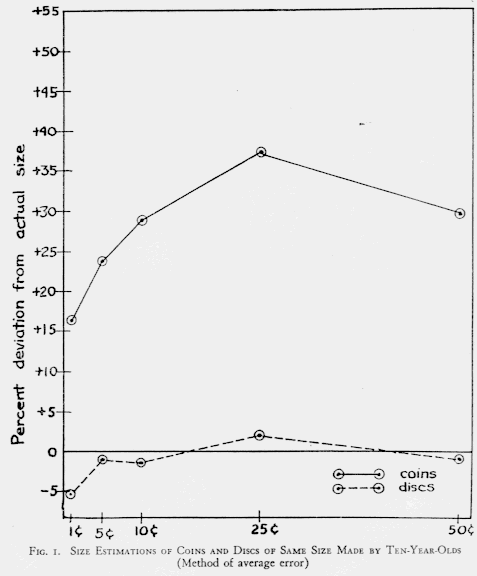
An internet resource developed by
[Classics Editor's Note: Footnotes are in square brackets; references
in round brackets]
Throughout the history of modern psychology, until very recent times, perception has been treated as though the perceiver were a passive recording instrument of rather complex design. One might, in most experiments, describe him in much the same graphical terms as one uses to describe the latest piece of recording apparatus obtainable from Stoelting or the American Optical Company. Such psychology, practiced as it were in vitro, has fallen short of clarifying the nature of perception in everyday life much as did the old nerve-muscle psychophysiology fall short of explaining behavior in everyday life. Both have been monumentally useful - in their place. The names of Weber, Fechner, Wundt, Titchener, Hecht, and Crozier are safely ensconced in any respectable psychological hall of fame. But their work, like the work of the nerve-muscle men, is only a beginning.
For, as Professor Thurstone (35) has put it, "In these days when we insist so frequently on the interdependence of all aspects of personality, it would be difficult to maintain that any of these functions, such as perception, is isolated from the rest of the dynamical system that constitutes the person." The problem is, indeed, to understand how the process of perception is affected by other concurrent mental functions and how these functions in their turn are affected by the operation of perceptual processes. Given a dark room and a highly motivated subject, one has no difficulty in demonstrating Korte's Laws of phenomenal movement. Lead the subject from the dark room to the market place and then find out what it is he sees moving and under what conditions, and Korte's Laws, though still valid, describe the situation about as well as the Laws of Color Mixture describe one's feelings before an El Greco canvas.
The discrepancy between the dark room and the market place we have in the past found it convenient to dismiss by invoking various dei ex machina: Attention, Apperception, Unbewusster Schluss, Einstellung, Preparatory Set, etc. Like the vengeful and unannounced step-brother from Australia in the poorer murder mysteries, they turn up at the crucial juncture to do the dirty work. Though such constructs are useful, perception itself must remain the primary focus. To shift attention away from it by invoking poorly understood intervening variables does little service. What we must study before invoking such variables are the variations perception itself undergoes when one is hungry, in love, in pain, or solving a problem. These variations are as much a part of the psychology of perception as Korte's Laws.
It is the contention of this paper that such perceptual phenomena are as scientifically measurable in terms of appropriate metrics as such more hallowed phenomena as flicker fusion, constancy, or tonal attributes. But let [p. 34] us pause first to construct a sketchy terminology. Let us, in what ensues, distinguish heuristically between two types of perceptual determinants. These we shall call autochthonous and behavioral. Under the former we group those properties of the nervous system, highly predictable, which account for phenomena like simple pair formation, closure, and contrast, or at another level, tonal masking, difference and summation tones, flicker fusion, paradoxical cold, and binaural beats. Given ideal "dark-room" conditions and no compelling distractions, the "average" organism responds to set physical stimuli in these relatively fixed ways. Autochthonous determinants, in brief, reflect directly the characteristic electrochemical properties of sensory end organs and nervous tissue.
Under the category of behavioral determinants we group those active, adaptive functions of the organism which lead to the governance and control of all higher-level functions, including perception: the laws of learning and motivation, such personality dynamics as repression, the operation of quasi-temperamental characteristics like introversion and extraversion, social needs and attitudes, and so on. Underlying these behavioral determinants, doubtless, are a host of physiological mechanisms. But we can hardly wait until we understand these before tackling experimentally the role of behavioral determinants in perception. The physiology of Weber's Law is still more or less obscure, yet the enunciation of it has been recognizably useful - even to the physiologist for whom it has been a challenge to discovery.
A paper of this kind cannot contain any extensive review of the literature on those perceptual dynamics which we have called behavioral. Yet it is necessary to pass rapidly over some of the notable facts and experiments which have forced us to draw certain distinctions and make bold claims about the mensurability of behavioral determinants. First we have the facts of "sensory conditioning," a term first used by Cason (8). Starting with the work of Perky in 1910 (24), it has been demonstrated repeatedly by Warner Brown (5), Ellson (11), Coffin (9), and others that subjects can be conditioned to see and hear things in much the same way as they can be conditioned to perform such overt acts as knee jerking, eye blinking, or salivating. Pair a sound and a faint image frequently enough, fail to present the image, and the subject sees it anyway when the sound is presented. Any student of suggestion, whether or not he has perused Bird's exhaustive bibliography (3) of the literature on the subject, knows that. Not perception? Why not? The subject sees what he reports as vividly as he sees the phi-phenomenon.
Closely related are such experiments as those of Haggard and Rose (16), Proshansky and Murphy (27), and Schafer and Murphy (31) demonstrating the role of reward and punishment in altering perceptual organization. Haggard and Rose show that the extent of autokinetic movement can be altered by a system of rewards; Proshansky and Murphy that discriminable differences in the perception of lines and weights can be similarly altered; Schafer and Murphy that, given an ambiguous figure-ground configuration, what is seen as figure and what as ground can be altered by a system of reward and punishment.
Another group of researches has demonstrated that what is seen in a complex configuration is not determined solely by the laws of gestalt, but by practice. Among experimenters who have confirmed this generalization [p. 35] are Henle (17), Fehrer (14), Braly (4), Leeper (20), and Djang (10). Closely related are the experiments of Thouless (34), showing that phenomenal constancy or, as he calls it, "regression to the real object," reflects the habits of the individual. Art students, for example, see the "real" object - its color, shape, and brightness - less readily, show greater phenomenal constancy, than matched individuals with no art training. Indeed, v. Fieandt (15) has shown that the appearance of a surface as light gray in shadow or dark gray in light can be controlled by simple Pavlovian conditioning, the CS being a sound or a button in the visual field. And all of us are fond of citing the work of Haddon in the Torres Straits (28) demonstrating that these primitive island spear-fishers are, most likely as a result of their experience with spears, considerably less susceptible to the Müller-Lyer illusion.
Sherif's classic experiments (32) on social factors are too well known to need any elucidation here. Demonstrating further the role of social factors in perception are the experiments of Zuk-Kardos (36) and Fazil (13), students of Egon Brunswik, who showed that the subjective number equation for matching a standard cluster of stamps or coins to a variable depended in part upon the value of the coins or stamps in the standard and variable clusters. With many refinements and extensions, these experiments have been repeated in America by Ansbacher (1).
One can go on to cite many more experiments, but in a very brief summary review that would be impossible. Let us conclude then with two pieces of research, one French, the other Swiss, indicating the possible connection of general personality traits and perception. Binet (2) and Meili and Tobler (22) have suggested that the child is more susceptible to "illusions," more a prey to those organizing factors which, as adults, we call distorting. Binet has shown that, as the child grows older, his susceptibility to the Müller-Lyer illusion decreases. The contribution of Meili and Tobler has been to show that, as the child ages, his threshold for seeing stroboscopic movement becomes higher. Whether from these two experiments, plus such incidental observations as Piaget's (25) to the effect that the child sees the moon as following him, we can draw any conclusions about increasing "perceptual realism" as a function of age is open to question. Yet the way has been opened to those who wish to investigate this area further.
So much for prior research. There exists a fruitful if slim body of literature on behavioral factors in perception. Where does one go from here? Two approaches are open. Armed with our slender reed of empirical proof, we can set about the task of systematization, indulging in S-R's, topology, or psychoanalytic constructs to suit the taste. There is already one brilliant theoretical structure to account for many of the facts we have been discussing, presented in Egon Brunswik's Wahrnehmung und Gegenstandswelt (7). Or we may go on to the empirical demonstration of general hypotheses concerning the relation of behavior dynamics and perception. Both are indispensable activities. The present paper, however, is concerned mainly with empirical hypotheses. But certain minimum systematic assumptions must first be made clear to bring these hypotheses into clear focus.
The organism exists in a world of more or less ambiguously organized sensory stimulation. What the organism sees, what is actually there perceptually represents some sort of compromise between what is presented by [p. 36] autochthonous processes and what is selected by behavioral ones. Such selection, we know, is determined not only by learning, as already indicated, but also by motivational factors such as have been indicated for hunger by Sanford (29, 30) and Levine, Chein, and Murphy (21). The selective process in perception we shall refer to as a perceptual hypothesis, using the term, with Krech (19), to denote a systematic response tendency. Such an hypothesis may be set into operation by a need, by the requirements of learning a task, or by any internally or externally imposed demands on the organism. If a given perceptual hypothesis is rewarded by leading to food, water, love, fame, or what not, it will become fixated; and the experimental literature, notably the work of Ellson (12) and Leeper (20), indicates that the fixation of "sensory conditioning" is very resistant to extinction. As fixation takes place, the perceptual hypothesis grows stronger not only in the sense of growing more frequent in the presence of certain types of stimulation, but also more perceptually accentuated. Perceptual objects which are habitually selected become more vivid, have greater clarity or greater brightness or greater apparent size.
Two other systematic matters must concern us before we turn to the experiments. One has to do with perceptual compromise, the other with perceptual equivocality. Frequently, alternative hypotheses operate: a quick glimpse of a man in gray on a European battlefield may leave us in doubt as to whether he is a civilian or a Wehrmacht infantry-man. Almost inevitably one or the other hypothesis prevails, and the field is perceived as either one or the other. But in spite of the dominance of a single hypothesis in perception, compromise also occurs. Using Ansbacher's experiments (1) as an example, a group of small paper squares is seen both in terms of number and in terms of value as stamps. What results, if you will, is a perception of "number-value." We know precious little about such perceptual compromises, although we shall be discussing experiments demonstrating their operation.
As for equivocality, or ambiguity in the perceptual field, it has generally been supposed that the greater the equivocality the greater the chance for behavioral factors in perception to operate, all other things being equal. Sherif (32) chose the autokinetic phenomenon to work with for this reason. Proshansky and Murphy (27) worked close to threshold illumination with similar intent. Within broad limits, which we shall discuss, the generalization is valid, in so far as equivocality reduces the organizing capacity of autochthonous perceptual determinants. How important this generalization is we, who think so exclusively in terms of the well-controlled dark-room experiment, often forget. For in everyday life, perception is, by and large, a series of quick looks, glances, inattentive listenings, furtive touches. Save for what is at the very focus of interested attention, the world of sense is more equivocal than our textbook writers seem to think.
1. The greater the social value of an object, the more will it be susceptible to organization by behavioral determinants. It will be selected perceptually from among alternative perceptual objects, will become fixated as a perceptual [p. 37] response tendency, and will become perceptually accentuated.
2. The greater the individual need for a socially valued object, the more marked will be the operation of behavioral determinants.
3. Perceptual equivocality will facilitate the operation of behavioral determinants only in so far as equivocality reduces the operation of autochthonous determinants without reducing the effectiveness of behavioral determinants.
In the experiments reported here, only one aspect of behavioral determination will be treated, what we have called accentuation - the tendency for sought-after perceptual objects to become more vivid. Perceptual selectivity and fixation have already been demonstrated in other experiments, though they remain poorly systematized. For purposes of economy of exposition we omit consideration of them here, though they constitute important variables in the broader research project of which the present experiments are a part.
Subjects individually sat in a chair in front of the screen on the box with the light circle slightly below eye level. The box rested on a table behind which sat the experimenter. The child was told that this was a game, and that he was to make the circle of light on the box the same size as various objects he was shown or told about. Before beginning judgments, each child, with no urging, was encouraged to see how large and small the circle of light could be made.
The two experimental groups received the same treatment. Two series were run for these groups, comprising 20 of the children in all. First the child was asked to estimate the sizes of coins from a penny through a half dollar from memory. He did the first in ascending order of value, then in descending order, always making two judgments for each coin named, one from the open, the other from the closed position of the iris diaphragm. Four judgments were made for each coin by each child. No inkling was given the child as to how "close" he had come.
Following the memory series, and using the same order of presentation, a similar series was then run with coins present. Coins, individually, were held close to the center of the palm of the left hand, at a level with the light circle and six inches to its left. The subjects took as much time as suited them.
A control group of ten subjects followed a procedure identical with the one just described. Instead of coins, medium gray cardboard discs of identi- [p. 38] cal size were employed. No mention of money was made to this group.

The difference between experimentals and controls is, of course, highly significant. The variance in overestimation in the experimental groups introduced by using coins of different value is similarly significant. Our results, as handled by the Postman-Bruner (26) adaptation of the analysis of variance to psychophysical data, show that variances due to coin value and due to using discs versus coins yield F-scores convertible to P-values of less than .01.[2]
So much for the first hypothesis, that socially valued objects are susceptible to behavioral determinants in proportion to their value. Consider now the second hypothesis, that the greater the subjective need for a socially valued object, the greater will be the role of behavioral determinants of perception. In the second experimental variation, the experimental group was divided into two component groups. One we call the rich group, the other the poor group, each comprising ten subjects. Well-to-do subjects were drawn from a progressive school in the Boston area, catering to the sons and daughters of prosperous business and professional people. The poor subjects came from a settlement house in one of Boston's slum areas. The reasonable assumption is made that poor children have a greater subjective need for money than rich ones. When the figures presented in Figure 1 are broken down into scores for rich and poor groups, a striking difference will be noted (Figure 2). The poor group overestimates the size of coins considerably more than does the rich. Again there are some irregularities in the curves. The drop-off for the half dollar we have already sought to explain. As for the dip in the rich group's curve at a dime, the explanation is problematical. All curves which we have plotted for adults - and by now we have collected more than two thousand judgments (6) - show this dip. Perhaps it is due to the discrepancy between the relative size and value of the dime, perhaps to some inherent characteristic of the coin itself.[3]
The difference between rich and poor is highly significant, analysis of variance showing that the source of variance is significant beyond the P level of .01. Our second hypothesis cannot, then, be rejected. It is notable too that the interaction between the parameters of economic status and value of coins yields an F-score convertible to a P-value between .05 and .01 which leads to a secondary hypothesis: given perceptual objects of the same class but varying in value, the effect of need for that class of objects will be to accentuate the most valuable objects most, the least valuable least, etc.
What of ambiguity or perceptual equivocality? We have arbitrarily [p. 40] assumed that a situation in which one is judging size from memory is more "equivocal" than one in which the object being judged is in clear view six inches away from the test patch.
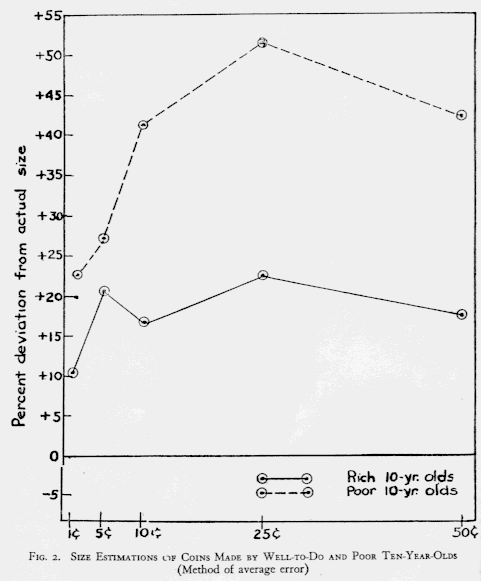
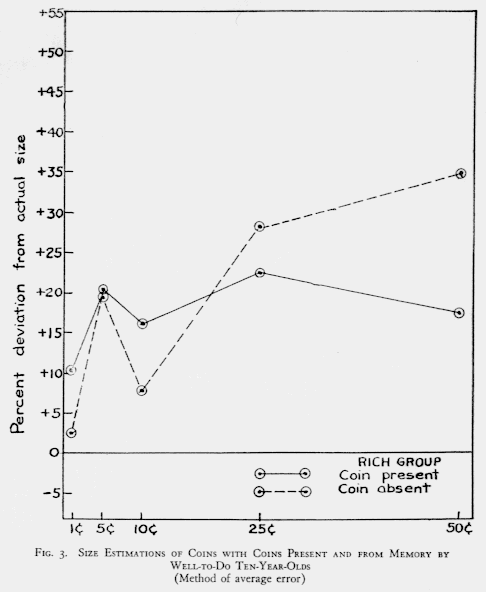
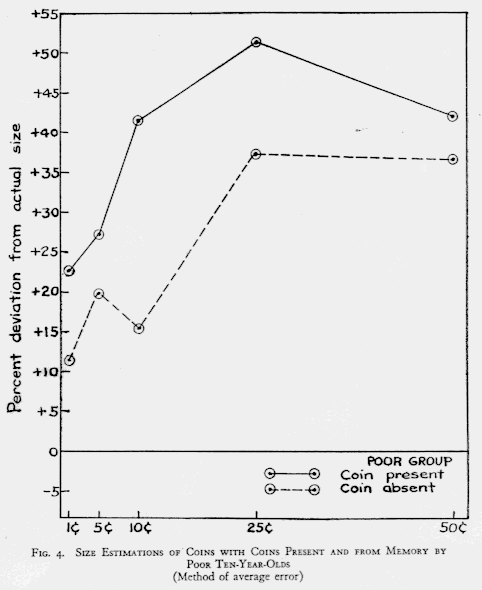
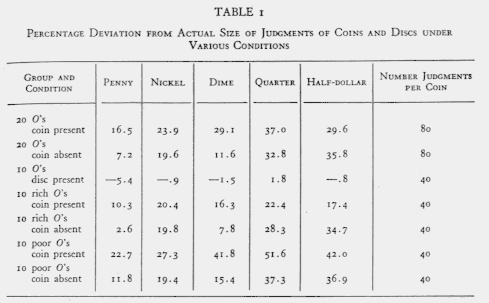
In conclusion, only one point need be reiterated. For too long now,
perception has been virtually the exclusive domain of the Experimental
psychologists with a capital E. If we are to reach an understanding
of the way in which perception works in everyday life, we social psychologists
and students of personality will have to join with the experimental psychologists
and reexplore much of this ancient field of perception whose laws for too
long have been taken for granted.
[2] P-values at the .01 level were also found for constant errors introduced by ascending and descending value orders and for judgments made from the open and closed positions of the diaphragm. Since these parameters were controlled and balanced in the judgment data for the groups discussed, nothing further need be said of them here. They will be discussed in another place (6). Analysis of variance was carried out both with percentage scores representing deviation of individual judgments from actual size and with raw scores. Necessary corrections suggested by Snedecor (33) were used in the former method. The values presented here are applicable to both raw and percentage scores.
[3] If the reader is a smoker, let him ask himself whether a dime will cover the hump on the camel which appears as a trademark on Camel cigarettes. Hold the two six inches apart. In spite of the apparently small size of the coin, it will cover the camel's hump with margin to spare.
[4] The difference between rich and poor children in
their size judgments of "absent" and "present" coins as here discussed
is statistically significant. The interaction variance for these two parameters
(economic status and presence-absence of coins) is at the .01 level of
significance.
2. Binet, A. La mesure des illusions visuelles chez l'enfant. Rev. phil., 1895, 40, 11-25.
3. Bird, C. Suggestion and suggestibility: a bibliography. Psychol. Bull., 1939, 36, 264-283.
4. Braly, K. W. The influence of past experience in visual perception. J. exp. Psychol., 1933, 16, 613-643.
5. Brown, W. Individual and sex differences in suggestibility. Univ. Calif, Publ. Psychol., 1916, 2, 291-430.
6. Bruner, J. S., & Postman, L. Perception and the dynamics of behavior. (In preparation.)
7. Brunswik, E. Wahrnehmung und Gegenstandswelt. Vienna, 1934.
8. Cason, H. Sensory conditioning. J. exp. Psychol., 1936, 19, 572-591.
9. Coffin, T. E. Some conditions of suggestion and suggestibility: a study of some attitudinal and situational factors influencing the process of suggestion. Psychol. Monogr., 1941, 241.
10. Djang, S. The role of past experience in the visual apprehension of masked forms. J. exp. Psychol., 1937, 20, 29-59.
11. Ellson, D. G. Hallucinations produced by sensory conditioning. J. exp. Psychol., 1941, 28, 1-20.
12. Ellson, D. G. Experimental extinction of an hallucination produced by sensory conditioning. J. exp. Psychol., 1941, 28, 350-361.
13. Fazil, A. Münzenversuche über Anzahl-, Grossen-, und Wertwahrnehmung. Cited by Ansbacher (1).
14. Fehrer, E. V. An investigation of the learning of visually perceived forms. Amer. J. Psychol., 1935, 47, 187-221.
15. v. Fieandt, K. A new constancy phenomenon in color perception. Ann. Acad. Sci. (Finland), 1938, 41 (summary in English). See also, Dressurversuche an der Farbenwahrnehmung. Arch. ges. Psychol., 1936, 96, 467-495.
16. Haggard, E. R., & Rose, G. J. Some effects of mental set and active participation in the conditioning of the autokinetic phenomenon. J. exp. Psychol., 1944, 34, 45-59.
17. Henle, M. An experimental investigation of past experience as a determinant of visual form perception. J. exp. Psychol., 1942, 30, 1-21.
18. Hollingworth, H. L. The inaccuracy of movement. Arch. Psychol., 1909, No. 13.
19. Krechevsky, I. "Hypothesis" versus "chance" in the presolution period in sensory discrimination learning. Univ. Calif. Publ. Psychol., 1932, 6, 27-44.
20. Leeper, R. A study of a neglected portion of the field of learning - the development of sensory organization. J. genet. Psychol., 1935, 46, 41-75.
21. Levine, R., Chein, I., & Murphy, G. The relation of the intensity of a need to the amount of perceptual distortion: a preliminary report. J. Psychol., 1942, 13, 283-293.
22. Meili, R., & Tobler, C. Les mouvements stroboscopiques chez les enfants. Arch. de Psychol., 1931, 23, 131-156.
23. Oeser, O. A. Personal communication, 1939.
24. Perky, C. W. An experimental study of imagination. Amer. J. Psychol., 1910, 21, 422-452.
25. Piaget, J. Language and thought in the child. London and New York, 1932.
26. Postman, L., & Bruner, J. S. The reliability of constant errors in psychophysical measurement. J. Psychol., 1946, 21, 293-299.
27. Proshansky, H., & Murphy, G. The effects of reward and punishment on perception. J. Psychol., 1942, 13, 295-305.
28. Rivers, W. H. R. Report of the Cambridge Anthropological Expedition to the Torres Straits, Vol. II, 1901.
29. Sanford, R. N. The effect of abstinence from food upon imaginal processes: a preliminary experiment. J. Psychol., 1936, 2, 129-136.
30. Sanford, R. N. The effect of abstinence from food upon imaginal processes: a further experiment. J. Psychol., 1937, 3, 145-159.
31. Shafer, R., & Murphy, G. The role of autism in a visual figure-ground relationship. J. exp. Psychol., 1943, 32, 335-343.
32. Sherif, M. A study in some social factors in perception. Arch. Psychol., 1935, No. 187.
33. Snedecor, D. Statistical methods. Ames, Iowa, 1940.
34. Thouless, R. H. Individual differences in phenomenal regression. Brit. J. Psychol., 1932, 22, 216-241.
35. Thurstone, L. L. A factorial study of perception. Chicago, 1944.
36. Zuk-Kardos, I. Perzeptionale Zugänglichkeit
von Anzahl, Fläche, und Wert unter verschiedenen Umstandskonstellationen.
Cited by Ansbacher (1).